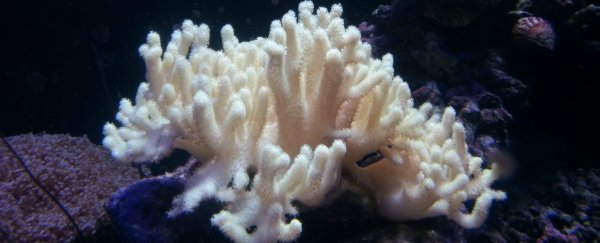The corals of the world are not doing well right now. Just last week, it was reported that as much as 93 percent of the Great Barrier Reef has been damaged by coral bleaching, and the effects of El Nino are causing strife for coral populations worldwide.
And things have just gotten even worse for Australian reef inhabitants, with marine biologists discovering that, for the first time ever, the Sydney Harbour coral populations have also suffered bleaching, with up to 45 percent at certain sites showing signs of damage.
Despite grim news for coral reefs elsewhere around the world, this was actually surprising for researchers, because Sydney's relatively cool climate usually prevents the water from heating up enough to cause bleaching. But the recent El Nino event, and increasing global temperatures has caused warmer summers and therefore seawater, causing the bleaching to occur.
"Although these corals are specialists in cooler waters, what we didn't expect to see was such a rapid change in their physiology. They appear to have bleached in a matter of weeks," said one of the researchers, Samantha Goyen, from the University of Technology Sydney (UTS). "Corals, wherever they are in the world, are a frontline climate change indicator."
This phenomenon was investigated by UTS's Climate Change Cluster, which says this is the first time bleaching is known to have happened in the southern city.
"To our knowledge, bleaching like this has never been observed in Sydney Harbour corals. Where we normally see corals here with vibrant hues ranging from iridescent green to a reddish-bronze, many of them are now showing clear signs of bleaching," said one of the researchers, Joshua Madin.
But bleaching isn't a definite death sentence for these corals. Corals have a symbiotic relationship with algae - which give them their bright colour - and when the stress of rising temperatures, water contamination, or turbulent conditions gets too much, the algae vacate the corals, leaving them white.
Bleaching is an extreme form of stress, where the coral has reached its breaking point, and has expelled all the symbiotic algae living in its tissue.
"Often we see that bleaching is the result of a synergistic effect of extreme water temperatures combined with high light levels, which further intensifies the stress," said one of the UTS team, Matthew Nitschke. "While some corals will bleach when either of these two conditions happen, some resilient species only bleach when the interplay of these two stressors tips them over the edge."
So the good news is that the Sydney corals should bounce back as long as the weather and stress subsides. Prolonged hot weather and stress can cause susceptibility to both starvation and disease, which is why the Great Barrier Reef is in so much strife right now.
"We are optimistic the corals can recover as conditions return to normal," says David Suggett, who leads the UTS Future Reefs research program. "However, we believe this serves as a good example of why we need to understand how organisms like corals, which are at the frontline of climate change, survive extremes and persist at the edge of their ranges."
As much as NASA, and a bunch of other scientific groups keep telling us that human-caused climate change is real, if weather hot enough to kill a whole ecosystem isn't going to convince governments to step up their game on climate change, we honestly don't know what will.
UTS Science is a sponsor of ScienceAlert. Find out more about their research.
